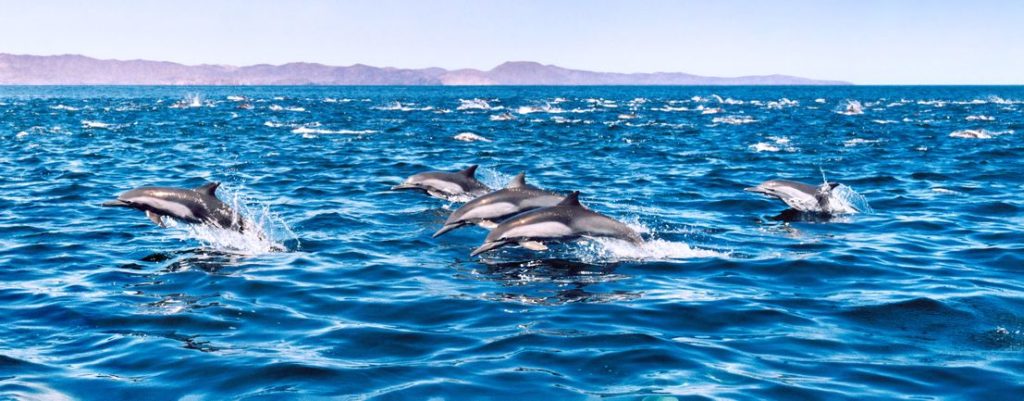Dolphins and Porpoises
Dolphins and Porpoises PBC’s Earth Hero Honoree 2017
For Educational Resources visit our Teacher Toolkit
Dolphins and porpoises are toothed whales. Porpoises and dolphins are both members of the same scientific order, Cetacea. Cetacea includes all whales, which are relatives of dolphins and porpoises. The Pacific White-sided Dolphins is easily recognized as dark above, white below, and possessing a broad-based dorsal fin that is strong re-curved with much white in the “web” and trailing edge. This dolphin is found year-round but is most abundant during warmer water regimes in fall & winter. It ranges in the north Pacific from southeastern Alaska to Baja California and from the Kuril Is. to Japan.
The other common species encountered very often in our waters is the Dall’s Porpoise. It is smaller and stockier than the White-sided and is a more adapted to cold water. It is found year-round but seems most common in cold water regimes in winter & spring. It does not typically engage in leaps and while it is often seen in small herds, it does not gather together in the hundreds as to the other mid-sized dolphins. What it does do is travel quickly leaving a “rooster-tail” spray in its wake. Indeed, this characteristic is so diagnostic that one author proposed calling it the “Spray Porpoise” (Watson 1981).
You can find 11 species of dolphins in California’s waters:
- Short-beaked common dolphin
- Long-beaked common dolphin
- Short-finned pilot whale
- Risso’s dolphin
- Pacific white-sided dolphin
- Northern right whale dolphin
- Killer whale
- False killer whale
- Pantropical spotted dolphin
- Striped dolphin
- Rough-toothed dolphin
- Common bottlenose dolphin
And 2 species of porpoises occur in California’s waters:
- Dall’s porpoise
- Harbour porpoise
Harbour porpoises were traditionally hunted for food, as well as for their blubber, which was used for lighting fuel. Among others, hunting occurred in the Black Sea, off Normandy, in the Bay of Biscay, off Flanders, in the Little Belt strait, off Iceland, western Norway, in Puget Sound, Bay of Fundy and Gulf of Saint Lawrence. The drive hunt in the Little Belt strait, Denmark, is the best known example. Thousands of porpoises were caught there until the end of the 19th century, and again in smaller scale during the world wars. Currently, however, this species is not subject to commercial hunting, but it is hunted for food and sold locally in Greenland.
The Harbour porpoise populations of the North Sea, Baltic Sea, western North Atlantic, Black Sea and North West Africa are listed on Appendix II of the Convention on the Conservation of Migratory Species of Wild Animals (CMS). In 2013, the two Baltic Sea subpopulations were listed as vulnerable and critically endangered respectively by HELCOM. These listings mean that these populations have an unfavourable conservation status or would benefit significantly from international co-operation organised by tailored agreements.
In addition, the Harbour porpoise is covered by the Agreement on the Conservation of Small Cetaceans of the Baltic, North East Atlantic, Irish and North Seas (ASCOBANS), the Agreement on the Conservation of Cetaceans in the Black Sea, Mediterranean Sea and Contiguous Atlantic Area (ACCOBAMS) and the Memorandum of Understanding Concerning the Conservation of the Manatee and Small Cetaceans of Western Africa and Macaronesia (Western African Aquatic Mammals MoU).
Currently, the total population is in the hundreds of thousands and the harbour porpoise is not under threat of extinction. There are, however, a number of threats that impact population distribution and numbers.
The Main Threat: Fisheries
The main threat to porpoises is static fishing techniques such as gill and tangle nets. Bycatch in bottom-set gill nets is considered the main anthropogenic mortality factor for harbour porpoises worldwide. Bycatch is reported from the Black Sea, the Baltic Sea, the North Sea and the east coast of the United States and Canada. Bottom-set gill nets are anchored to the sea floor and are up to 12.5 miles (20.1 km) in length. It is unknown why porpoises become entangled in gill nets, since several studies indicate they are able to detect these nets using their echolocation. Porpoise-scaring devices, so-called pingers, have been developed to keep porpoises out of nets and numerous studies have demonstrated they are very effective at reducing entanglement.
Climate change
An increase in the temperature of the sea water is likely to affect the distribution of porpoises and their prey, but has not been shown to occur. Reduced stocks of sand eel along the east coast of Scotland seems to have been the main reason for the malnutrition in porpoises in the area.
Noise pollution
Noise from ship traffic and oil platforms is thought to affect the distribution of toothed whales, like the harbour porpoise, that use echolocation for communication and prey detection. The construction of thousands of offshore wind turbines, planned in different areas of North Sea, is known to cause displacement of porpoises from the construction site, particularly if steel monopile foundations are installed by percussive piling, where reactions can occur at distances of more than 20 km. Noise levels from operating wind turbines are low and unlikely to affect porpoises, even at close range.
Pollution
Marine top predators like porpoises and seals accumulate pollutants such as heavy metals, PCBs and pesticides in their fat tissue. Porpoises have a coastal distribution that potentially brings them close to sources of pollution. Porpoises may not experience any toxic effects until they draw on their fat reserves, such as in periods of food shortage, migration or reproduction. These types of pollution also affect the bees and the sea otters.
Did you know?
Dolphins eat less in the summer than in the winter because in the winter they need more calories to survive the colder water temperatures.
Dolphins usually have beak-like, pointed snouts, while porpoises have blunt, rounded noses. Porpoises have triangular dorsal fins, like a shark. Dolphins, on the other hand, have dorsal fins that are more curved like a wave.
The teeth of the two animals offer an easy way to tell them apart. Porpoise teeth are flat and rectangular. Dolphin teeth are cone-shaped.
Find more dolphin fun facts on our special fun facts page!
Information found on Wikipedia, Wonderopolis.org and MontereyBay.com.

